GERMANY
History

History

Cities in GERMANY
| Berlin | Cologne | Dortmund |
| Frankfurt | Hamburg | Heidelberg |
Popular destinations GERMANY
| Bavaria |
History
Prehistory and Antiquity
Some of the human remains found in Germany are among the oldest found in Europe. Still, artifacts from before the Riss / Saale Ice Age, c. 150,000 BC. are very very rare. From the time of the Neanderthals, objects have been found in both caves and open-air camp sites. From the Magdalenian (18,000-10,000 BC) there are unique camping sites where slate plates with images of people and animals can be seen. Remains of the Hamburg culture date from the same period. These were reindeer hunters who were the oldest inhabitants of the North German lowlands.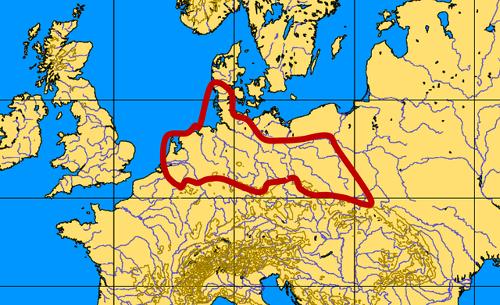 Location of the Hamburg-culture, GermanyPhoto: Merikanto CC 4.0 International no changes made
Location of the Hamburg-culture, GermanyPhoto: Merikanto CC 4.0 International no changes made
At the end of the period 8200-5300 BC, the earliest Neolithic, we encounter the first farmers of the band-ceramic culture (5300-4800 BC). This is followed by the Rössen culture (4800-4400 BC) and the Michelsberg culture (4400-3600 BC).
In the north, flint axes from the Mesolithic have been found and there is evidence that around 4500 BC. contacts are between the north and the south of Germany. These contacts lead to the Ellerbek-culture, which was founded around 3800 BC, and is succeeded by the funnel beaker culture from 3100 BC. Until the beginning of the Bronze Age, different cup cultures existed throughout Germany.
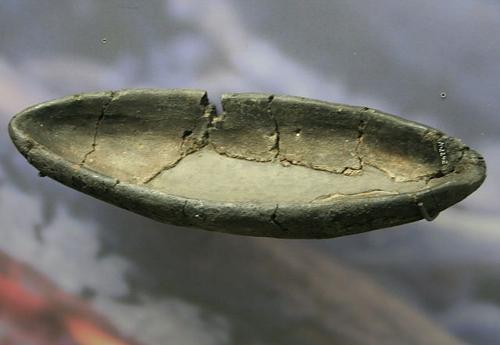 Ellerbek artefact from the Archäologisches Landesmuseum Schleswig-HolsteinPhoto: Einsamer Schütze CC 3.0 Unported no changes made
Ellerbek artefact from the Archäologisches Landesmuseum Schleswig-HolsteinPhoto: Einsamer Schütze CC 3.0 Unported no changes made
Centers of bronze industries with burial mounds and armor have been found in both the south and the north of Germany. Princes' tombs with riches show for the first time that social layers in the population can be distinguished.
The Iron Age, from 750 BC, is divided into the Hallstatt culture and the La Tène culture with finds of very rich royal tombs and royal castles. The La Tène culture is further characterized by the early formation of cities. Wherever the Romans did not settle, the Iron Age continued until the time of the migrations, ca.375 AD.
Germany to 843 AD.
The present-day German territory was inhabited around the beginning of the era by Germanic peoples and to the east by Slavic peoples. There was no real state formation yet, but sometimes some groups were led by what you could call a king. Julius Caesar's Roman legions subdued some Germanic peoples south and west of the Rhine. The Roman name Germania also dates from this time.
During the period of Emperor Augustus, Germany was occupied by the Romans up to the Elbe. However, this did not last long, because after the lost Battle of the Teutoburg Forest in AD 9, the Rhine again became the extreme northern border and in the south the Danube.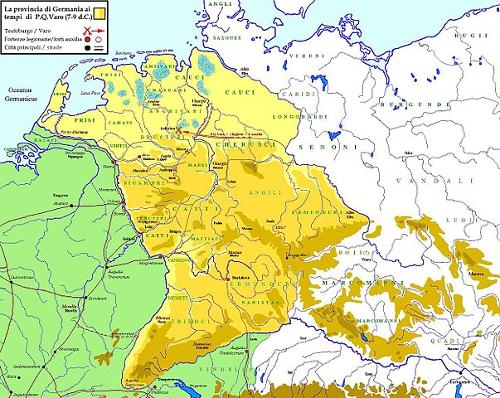 Roman Germania in the year 7-9 ADPhoto: Cristiano64 CC 3.0 Unported no changes made
Roman Germania in the year 7-9 ADPhoto: Cristiano64 CC 3.0 Unported no changes made
Ultimately, the Franks became the leading power in this region. Under Charlemagne, Germany, west of the Elbe and along the Danube to present-day Hungary, belonged to the Frankish Empire.
The German Empire in the Middle Ages
The German Empire actually arose after the Treaty of Verdun in 843 and the Treaty of Meerssen in 870. In Verdun, the Frankish Empire was divided among the three sons of Louis the Pious. Lothair became emperor and ruled Italy, the Provence and a long strip of Burgundy over Lorraine and Brabant towards Friesland. Charles the Bald got old Gaul in the west and Louis the German got some areas on the left bank of the Rhine. Lothair's empire was divided among his three sons after his death in 855. Louis II received Italy with the imperial crown; Charles received the southern part of the central zone extending from the Mediterranean to the North Sea and Lothair II the northern part of it.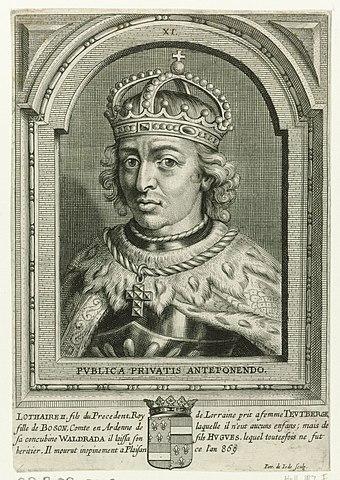 Lotharius II, king of LorrainePhoto: Rijksmuseum in the public domain
Lotharius II, king of LorrainePhoto: Rijksmuseum in the public domain
The boundary between the northern and southern part was formed by the Langres Plateau. This northern part was given the name of its ruler: Lorraine (Regnum Lotharii). After the death of Lothair II, his empire was divided between Charles the Bald and Louis the German (Treaty of Meerssen, 870). The border between the French and the German Reichs approximately coincided with the rivers Saône and Maas. In 880 Lorraine came entirely to Louis the Younger, son and successor of Louis the German, and the Scheldt became and remained the border current for many centuries.
Imperial authority meant little in this time. The Carolingian pretenders to the throne competed for supremacy and the tribal dukes became increasingly powerful. The last German Carolingian king would turn out to be Louis the Child. He surrendered his crown to the Duke of Franconia, Conrad I. He was succeeded in 919 by Henry I and with him began the great era of the German Reich, which would last until 1250. Kings and emperors of the Saxon House, the Salic House and the House of the Hohenstaufen ruled successively. The policy of the German kings can be divided into three: the central imperial power was not to be lost; They wanted to enlarge the empire area to the east of the Elbe and they fought against the popes for dominance of the church, the so-called investiture battle. Otto I was one of the great emperors to be the first non-Carolingian German king to be crowned emperor in 962, and he managed to extend his authority even more vis-à-vis secular princes, popes and bishops.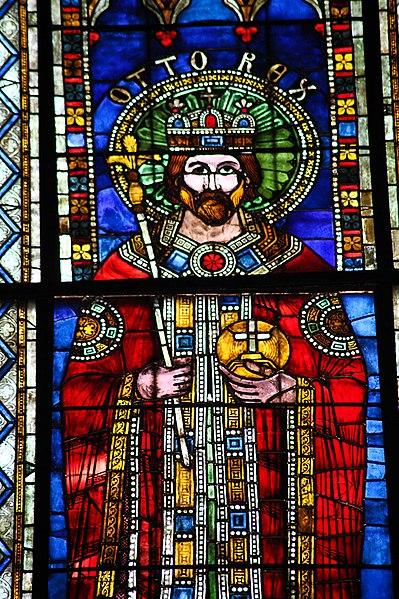 Otto I "The Great", Holy Roman Emperor, GermanyPhoto: Playing Futures: Applied Nomadology CC 2.0 no changes made
Otto I "The Great", Holy Roman Emperor, GermanyPhoto: Playing Futures: Applied Nomadology CC 2.0 no changes made
Since that time it has been referred to as the German Empire or the Holy Roman Empire of the German nation. In the reign of Henry IV and his successors, the Investiture Controversy was raging, which ended with the Concordat of Worms in 1122, which stipulated that the choice of bishops was transferred to the clergy. Under Frederick I, the German Empire was at the height of its power.
After the death of Conrad IV in 1254, turbulent times began, the so-called Interregnum. The electors elected Rudolf Van Habsburg as king, after which the electors could actually do whatever they wanted for about 150 years and there was no strong central authority. Germany splintered into a federation with great principalities, free cities and many lords. With Albrecht II, the German crown definitely went to the Habsburgs.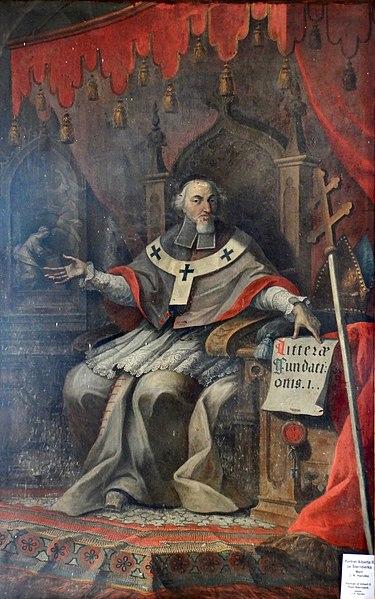 Albrecht II "The Magnanimous", king of GermanyPhoto: Michal Manas CC 4.0 International no changes made
Albrecht II "The Magnanimous", king of GermanyPhoto: Michal Manas CC 4.0 International no changes made
The German Empire under the Habsburgs
Under the reign of Maximilian I (1493-1519), attempts were made to implement some political reforms, but the damage had long been done. The political disintegration could no longer be stopped and eventually about 2500 states would arise around the time of the Reformation. Emperorship was being increasingly eroded and the Reichsstag, which united the three estates, electors, princes and free cities, could not play a central role in political relations. In the areas that became Protestant, the city councils and the monarchs managed to further strengthen their position of power. An own ecclesiastical organization was even established, the “Landeskirchentum”.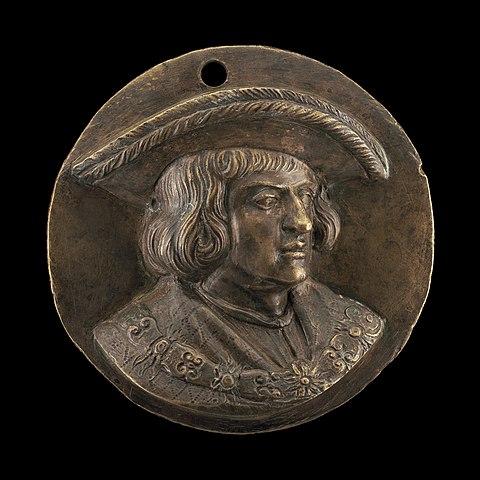 Maximilian I, Archduke of Austria, holy Roman EmperorPhoto: Public domain
Maximilian I, Archduke of Austria, holy Roman EmperorPhoto: Public domain
The religious division led to much unrest, especially on the Roman Catholic side, and eventually led to the Thirty Years' War. The Catholic Habsburgs also hoped to restore imperial authority through this war.
At the height of Catholic successes, Ferdinand II promulgated the Restitution Edict in 1629, which indirectly also was to underpin his imperial authority. It then became clear, however, that even the German allies of the Habsburg House put the unrestricted maintenance of the liberity of the empire above the importance of the Catholic cause, so that the whole endeavor came to nothing. In the later phase of the Thirty Years' War, when it was clear that European conflicts of power were in fact being fought on German soil, although a rapprochement took place between the emperor and the other German princes, it was already too late to counteract the fatal development.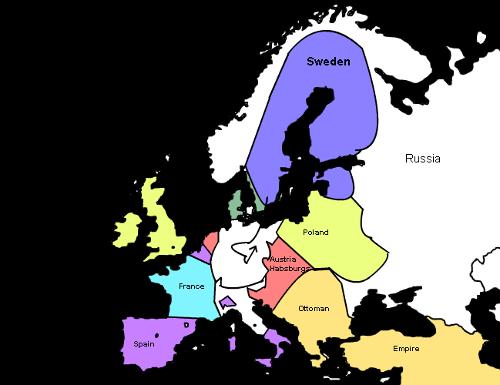 Borders of Europe during the Thirty Years WarPhoto: Public domain
Borders of Europe during the Thirty Years WarPhoto: Public domain
The Peace of Westphalia (1648), which definitively regulated religious relations in the Holy Roman Empire and thus ended the protracted conflict, has been disastrous for the German nation in other respects. The Empire, which had endured the most severe trials during that war, now suffered for its powerlessness with the loss of vast areas, especially in the west, and weakened more and more in its political structure. Little more was left of emperorship than an empty title, and the individual German states that had acquired the “Ius foederationis” were now allowed to pursue their own foreign policy almost without restrictions.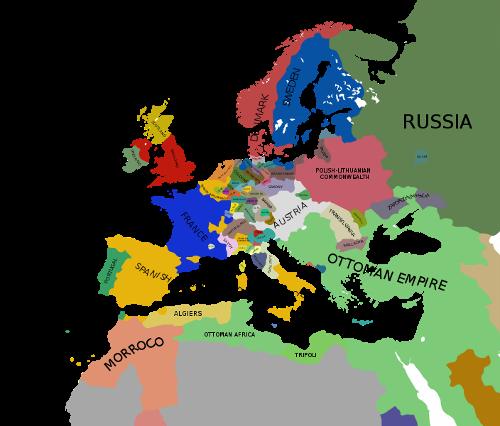 European map after the Peace of Westphalia in 1648Photo: Amitabho CC 3.0 Unported no changes made
European map after the Peace of Westphalia in 1648Photo: Amitabho CC 3.0 Unported no changes made
With the rise of Brandenburg-Prussia, the era of Austro-Prussian dualism was heralded in national politics. This marked the final phase of the political decline of the Holy Roman Empire. Both superpowers saw the rest of the Empire as room for maneuver for their political interests and were followed by smaller countries such as Saxony, Bavaria and Hanover. It was typical of this situation that the people finally called only the fragmented areas on the Middle Rhine the Empire.
French rule
The era of the revolutionary and Napoleonic wars in the period 1792-1815 would have major political consequences. For example, France annexed all the land on the left bank of the Rhine and the large German states received some small dwarf states as compensation. Napoleon thus ensured that the French influence in Germany became stronger and stronger. In 1806, sixteen German monarchs founded the Confederation of the Rhine, which marked the definitive end of the Holy Roman Empire. The last emperor, Francis II, who was also Emperor of Austria since 11 August 1804, resigned the emperorship on 6 August 1806 under French pressure.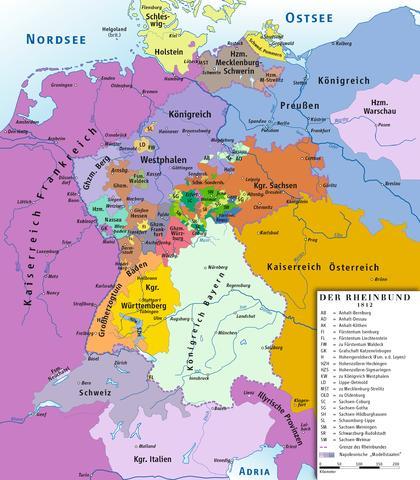 The Confederation of the Rhine was a confederation of client states of the First French EmpirePhoto: Ziegelbrenner CC 3.0 Unported no changes made
The Confederation of the Rhine was a confederation of client states of the First French EmpirePhoto: Ziegelbrenner CC 3.0 Unported no changes made
Not long afterwards, Prussia went to war with France and lost half its territory. The remaining Prussian territory, however, was subject to heavy material burdens, and was therefore bound hand and foot to France. The former Prussian territories were divided among the Confederation of the Rhine. In 1810 a broad coastal strip in northwestern Germany was annexed by the French, where the important port cities of Bremen, Hamburg and Lübeck were located.
With the exception of Prussia and Austria, the Confederation of the Rhine had meanwhile been expanded to include all existing German states. However, this league was entirely dependent on France and an instrument of French politics. Most Germans did not suffer much from the fact that the German nation had more or less fallen under French rule. Strong anti-German sentiments existed only in Prussia. This even led to a liberation war of 1813-1815, of which the population was hardly impressed.
On the way to German unity
Only after the Congress of Vienna in 1815 did national feelings bubble up again. Germany remained divided into 39 states of different sizes and significance, often with fragmented territory. Together these states formed the German Confederation. Prussia was dissatisfied because it came second in German politics. This was partly because the Berlin ministers joined forces with Klemens Metternich, who single-handedly determined the course of the German Confederation.
He was a declared opponent of all national and liberal movements and tried to slow down the development towards constitutionalism. The German states that already had a constitution were also prevented from pursuing liberal rule. The League intervened more and more, but in Prussia in particular, an increasingly closer unity became, mainly out of economic self-interest. It even created a “Zollverein” which, by 1834, already included most of the German states.
After the March Revolution of 1848, all nationalist and radical currents converged in Germany and the first elected national assembly met in Frankfurt. The task of this meeting was to give the future German Reich a liberal constitution and a provisional Reich government was also established under the leadership of Archduke Johan. Due to major political differences, this attempt came to nothing.
In 1849 the constitution finally came into effect and the German lands, except Austria, were united in a hereditary empire under Prussian rule. The Prussian king, however, refused to become emperors, and liberal nationalism suffered a heavy defeat. Prussia tried to establish a German Union, but failed due to the intervention of Austria and Russia, and in 1850 the old German Confederation was restored. Austria lost a lot of authority in German politics due to, among other things, a defeat in Italy. As a result, Prussia became increasingly powerful, both militarily and economically. In 1862, the conservative Otto von Bismarck came to power in Berlin, and a major internal crisis soon developed within the German Confederation. Bismarck was at odds with the liberals in his own Prussia and tried to fight Austrian hegemony with the help of liberals and radical nationalists in other German countries. This eventually led to a German fraternal war in 1866, in which Austria and its allies were severely defeated.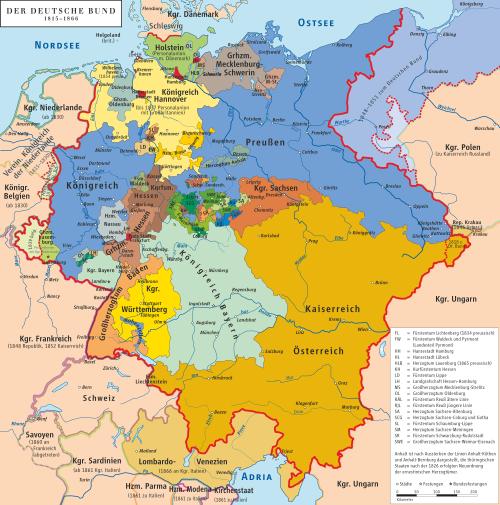 The German Confederation (German: Deutscher Bund) was a confederation of more than 40 German statesPhoto: Ziegelbrenner CC 3.0 Unported no changes made
The German Confederation (German: Deutscher Bund) was a confederation of more than 40 German statesPhoto: Ziegelbrenner CC 3.0 Unported no changes made
As a result, the German Confederation disintegrated and the Peace of Prague effectively pushed Austria out of German politics. Prussia grew stronger and with the German states to the north of the river Main founded the North German Confederation, a much stronger body than its predecessor with even an elected parliament. The southern German states became formally independent and concluded alliance treaties with the North German Confederation, which in particular strengthened economic ties.
Because of these treaties, the efforts of Austria and France to play the South Germans against Prussia also failed. In 1871, a war between the North German Confederation and the South German states on the one hand and France on the other ensured that German unity became a fact.
The Hohenzollern Empire
On January 18, 1871, the German Empire was founded by Bismarck in Versailles. The Prussian King Wilhelm I became the German Emperor, only the Habsburg Empire was excluded and there was no question of a Greater German Empire for the time being. It was also disappointing that it was in fact a royal league under Prussian leadership and not the desired liberal constitutional monarchy. As a result, Bismarck continued to exert a great influence on the new empire and the crown and the old feudal upper class continued to rule and the influence of the citizens was curtailed.
Moreover, the individual states, in particular Bavaria, with their princes and their own governments continued to exist as usual, and the office of Reich Chancellor usually coincided with that of Prussian Prime Minister. This created a complex two-unity relationship between the Empire and between Prussia, in which foreign policy and the most important domestic affairs were determined by the Reich government. Bismarck cleverly managed to ensure a majority in the Reichstag and thus played the parties off against each other.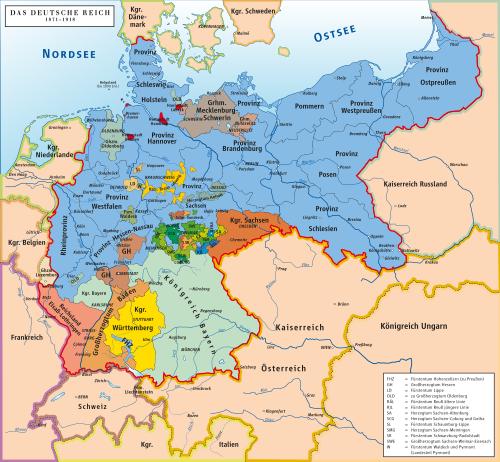 Map of German Reich 1871–1918Photo: Ziegelbrenner CC 3.0 Unported no changes made
Map of German Reich 1871–1918Photo: Ziegelbrenner CC 3.0 Unported no changes made
He had first allied himself with the liberals through his unity politics. Together with the liberals, he tried to break the cultural influence of internationally oriented Catholicism in order to make cultural and religious matters an exclusive state affair. This so-called "Kulturkampf" was only ended around 1878 after a series of highly controversial anti-church measures. In addition, moderate Leo XIII became Pope and Bismarck desperately needed the Catholic Center Party again.
In the meantime, Germany had been transformed from a predominantly agricultural country into an industrial society. Industry was protected so much by Bismarck through protectionist policies that he came into conflict with the liberals and their free economic ideas. Mainly relying on the agrarian conservatives, he also came into increasing conflict with the socialists, which he tried to mask by means of social insurance. In 1888, Wilhelm II accepted the crown, and his progressive plans soon led to conflicts with the chancellor, ultimately resulting in Bismarck's dismissal in 1890.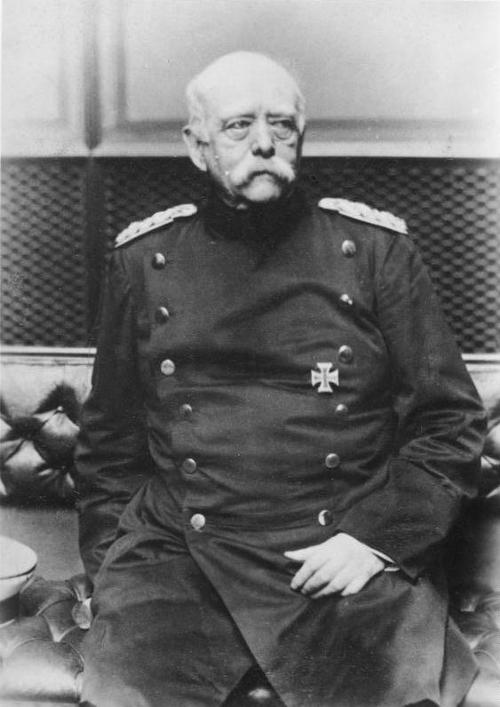 Otto von Bismarck (1815-1898), Prime Minister of Prussia (1862 to 1890) and in 1867 Chancellor of the North German ConfederationPhoto: Bundesarchiv, Bild 183-R13234 CC-BY-SA 3.0 no changes made
Otto von Bismarck (1815-1898), Prime Minister of Prussia (1862 to 1890) and in 1867 Chancellor of the North German ConfederationPhoto: Bundesarchiv, Bild 183-R13234 CC-BY-SA 3.0 no changes made
Bismarck's foreign policy was to maintain peace and for this purpose alliances were to be formed. An important goal was to weaken the influence of France. In 1878 an upcoming conflict in the Balkans could be nipped in the bud. He also managed to bind the opponents Austria and Russia to Germany. Nevertheless, Germany's strong position turned out to be an illusion and Germany's position in international relations was greatly overestimated. In 1892 the French and Russians allied and in 1904 the English and French. These thoughts were fueled by the tremendously prominent position in the world market of the economy after the United States and Great Britain.
Under Bismarck, a colonial empire had already emerged in Africa and Oceania and this imperialist aim was getting stronger (including China and the Near East). This imperialist behavior and the defiant attitude in many international tensions drove Germany into isolation, so much so that at one point it was only supported by the divided Habsburg monarchy.
In the First World War, the militarily powerful Germany, together with Austria, stood against a British-Franco-Russian alliance. Germany was only supported by Turkey and Bulgaria. The fronts were in France and Poland and it was possible to keep the war activities outside Germany. The people of Germany showed a remarkable unanimity, and even the Socialists supported the large expenditures associated with the war, but the war was increasing in casualties, the allies did not cooperate well, and the opponents grew to about thirty states, and a rapid victory proved impossible.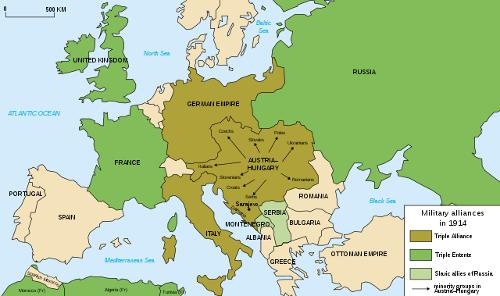 Map of military alliances in World War I in 1914Photo: historicair/Fluteflute&User:Bibi Saint-Pol CC 2.5 Generic no changes made
Map of military alliances in World War I in 1914Photo: historicair/Fluteflute&User:Bibi Saint-Pol CC 2.5 Generic no changes made
This created unrest among the population who wanted constitutional reforms again in order to end the powerful position of the old elite. Peace was made with Russia in 1918, but partly due to the participation of the United States in the war, Germany fought a losing battle on the Western Front and total collapse followed. On November 9, 1918, the monarchy came to an end and the Republic was proclaimed.
The Weimar Republic
The new republic initially had the difficult task of negotiating an armistice and then making peace with the victors. On June 28, 1919, the Treaty of Versailles was concluded and Germany had to cede Alsace-Lorraine, other border regions and all of the colonies. Furthermore, the eastern border was re-established with the result that East Prussia was added to Poland and this was experienced as very humiliating by the Germans. The army was greatly reduced and high reparations had to be paid. In Weimar, a democratic constitution had meanwhile been drawn up with still fairly large powers for the president. The first Reich President was the socialist Friedrich Ebert.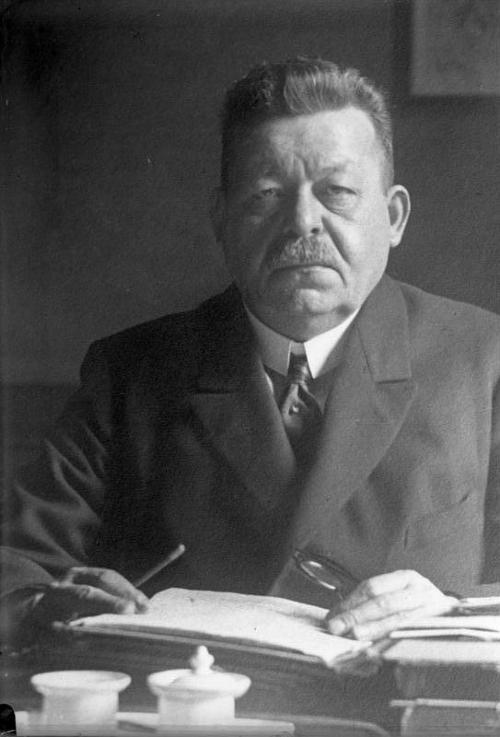 Friedrich Ebert (1871-1925), 1st Reich President of GermanyPhoto: Bundesarchiv, Bild 102-00015 / CC-BY-SA 3.0 no changes made
Friedrich Ebert (1871-1925), 1st Reich President of GermanyPhoto: Bundesarchiv, Bild 102-00015 / CC-BY-SA 3.0 no changes made
The first years of the Weimar Republic were characterized by economic misery and political chaos. In 1923 the provisional low point was reached by the French Ruhr occupation and the inflation that disrupted the entire economy. Right-wing and left-wing radical movements threatened unity. The following years brought about a normalization and improvement of the situation in the country. International tensions eased with the Locarno Pact in 1925.
In 1929 the global economic crisis broke out and Germany was also hit hard. Unemployment grew enormously and that was an excellent breeding ground for all kinds of radical groups to manifest themselves more and more emphatically, in particular the Nationalsozialistische Deutsche Arbeiterpartei (NSDAP) of Adolf Hitler benefited from this and in 1930 obtained 107 seats in the Reichstag and thus became the second party. of Germany after the SPD. Between 1930 and 1933 some extra-parliamentary cabinets tried to overcome the economic and political situation. However, the socialists were soon eliminated and in 1932 the NSDAP emerged as the strongest party.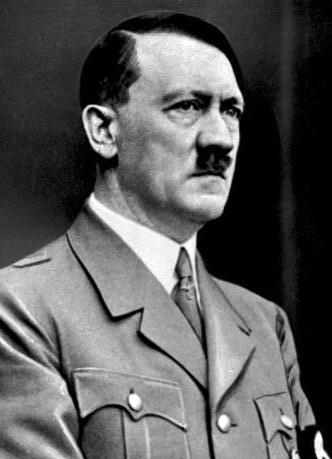 Adolf Hitler (1889-1945), Führer and Chancellor of GermanyPhoto: Bundesarchiv, Bild 183-S33882 / CC-BY-SA 3.0 no changes made
Adolf Hitler (1889-1945), Führer and Chancellor of GermanyPhoto: Bundesarchiv, Bild 183-S33882 / CC-BY-SA 3.0 no changes made
Under the constant threat of a military coup d'état and the massive support of the NSDAP, no government dared to act against Hitler's National Socialists and Fascists. On January 30, 1933, he even became chancellor of a cabinet of National Socialists, German Nationals and non-party conservatives.
The Third Reich
In an ingenious, ruthless way, Hitler managed to eliminate all coalition partners within a few months and a dictatorial one-party regime based on terror emerged, resulting in an unparalleled totalitarian state. Trade unions were dissolved, other parties were eliminated, the first persecutions of the Jews took place and concentration camps were established.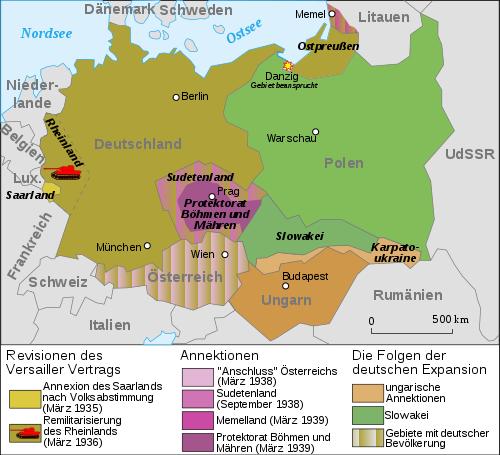 Germany during World War IIPhoto: Dani (talk) Extension_of_Germany_(1935-1939)-es.svg CC 2.5 no changes made
Germany during World War IIPhoto: Dani (talk) Extension_of_Germany_(1935-1939)-es.svg CC 2.5 no changes made
Hindenburg, President of the Reich since 1925, died in August 1934, which offered Hitler the opportunity to become head of state and thus also dictator. Slowly he managed to get rid of all opponents and he also managed to gain power from the army. All this was made even easier for him by the rising international economy, which actually improved the economic situation after the crisis years. Foreign policy became more and more aggressive, aided by weakness and the West's tendency to make concessions. It soon became clear that Hitler was heading for war. Austria and the Sudetenland were annexed in 1938 and Bohemia, Moravia and Memelland followed in early 1939. On September 1, Hitler invaded Poland and World War II broke out.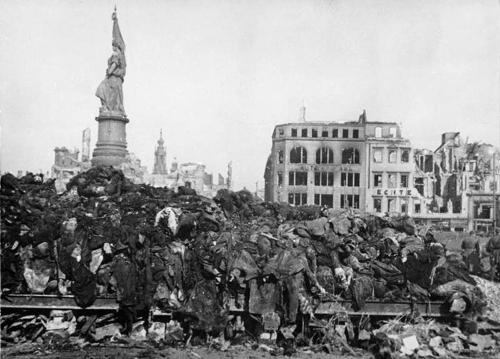 Consequences of the bombing of DresdenPhoto: Bundesarchiv, Bild 183-08778-0001 / Hahn / CC-BY-SA 3.0 no changes made
Consequences of the bombing of DresdenPhoto: Bundesarchiv, Bild 183-08778-0001 / Hahn / CC-BY-SA 3.0 no changes made
The Germans soon managed to conquer most of the European continent. Only after the failed attack on Russia in June 1941, the odds turned. Britain, the United States and the Soviet Union now jointly turned against the German Wehrmacht and the war ended in total defeat for Germany in May 1945. Only now did the true nature of fascist rule emerge with the discovery of the concentration camps where, among other things, six million Jews were murdered.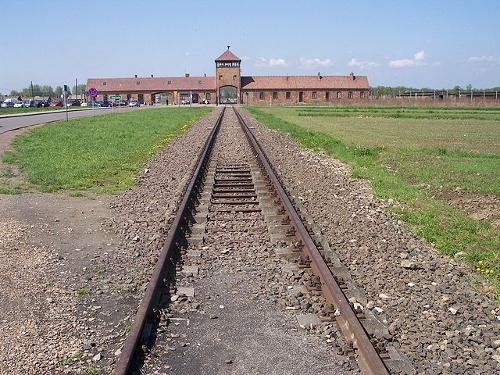 Rail leading to the German Nazi death camp Auschwitz II (Birkenau)Photo: Pimke CC 2.5 Poland no changes made
Rail leading to the German Nazi death camp Auschwitz II (Birkenau)Photo: Pimke CC 2.5 Poland no changes made
The period 1945-1949
After the war, Germany was divided into four occupation zones. The purpose of this was to govern the country jointly and to establish a democratic government. However, because of the contradictions between the United States, Great Britain and France on the one hand and the Soviet Union on the other, this plan failed miserably and after 1945 two separate states developed: the Federal Republic of Germany (FRG) and the German Democratic Republic (GDR), both of which came about in 1949.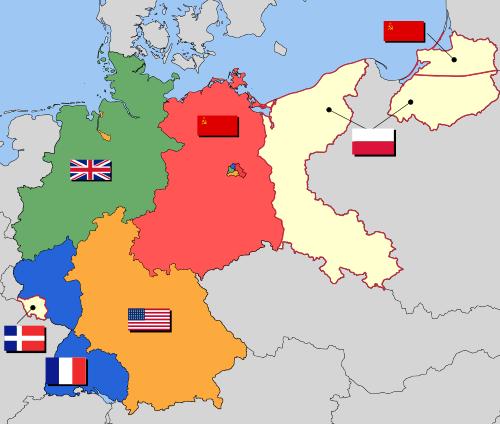 Germany divided by the Allies after World War IIPhoto: 52 Pickup CC 2.5 Generic no changes made
Germany divided by the Allies after World War IIPhoto: 52 Pickup CC 2.5 Generic no changes made
The Federal Republic of Germany 1949–1990
The Federal Republic of Germany was formed on August 14, 1949 from the US, British and French occupation zones. According to the 1950 agreements, the western sectors of Berlin became a Land of the Federal Republic. The Saarland, occupied by the French, joined the Federal Republic on January 1, 1957. Finally, the Reunification Treaty - which on Oct. 1990 came into effect - the affiliation (Beitritt) of the German Democratic Republic (GDR) with the Federal Republic of Germany.
The first Bundestag elections were held in 1949, on the same day the new constitution came into effect. On September 12 the first president was elected, Theodor Heuss of the FDP. A few days later, Konrad Adenauer was elected Chancellor of the CDU, and then re-elected three more times, the last time in 1961.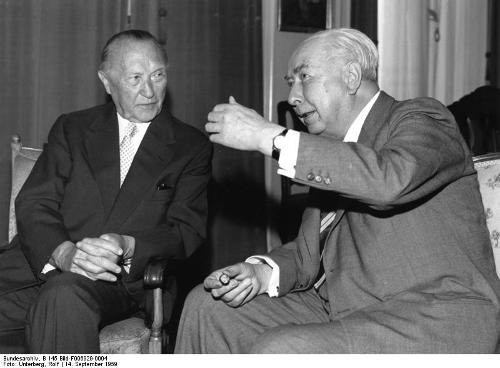 Konrad Adenauer (1876-1967), first chancellor of West-Germany, and Theodor Heuss, first federal president of West-GermanyPhoto: Bundesarchiv, B 145 Bild-F006929-0004 / Rolf Unterberg / CC-BY-SA 3.0 no changes made
Konrad Adenauer (1876-1967), first chancellor of West-Germany, and Theodor Heuss, first federal president of West-GermanyPhoto: Bundesarchiv, B 145 Bild-F006929-0004 / Rolf Unterberg / CC-BY-SA 3.0 no changes made
A coalition party of CDU, FDP and Deutsche Partei (DP) was formed, which mainly focused on intensifying contacts with the west and putting reunification with the GDR in the background. The socialists, liberals and the refugee party, on the other hand, focused more on reunification with the GDR. The CDU also won the next two elections in 1953 and 1957. In 1953 a coalition of the CDU, FDP, DP and Refugee Party was formed which received a two-thirds majority in both the Bundestag and the Bundesrat. In 1955 the Refugee Party left the coalition and in 1956 the liberals followed suit. At that time, the opposition socialists were making progress in the state elections.
In the meantime, the so-called “Wirtschatfswunder” took place in Germany, the strong economic progress from which the workers also benefited.
In 1961 the CDU won the elections again, but this time did not achieve a convincing majority, partly due to a number of internal conflicts. Adenauer had to include the FDP as a coalition partner in his government and was replaced in October by Ludwig Erhard, the main man behind the economic miracle. In 1965, Willy Brandt's socialists were again clearly defeated by the CDU and Erhard was able to form a cabinet again with the FDP.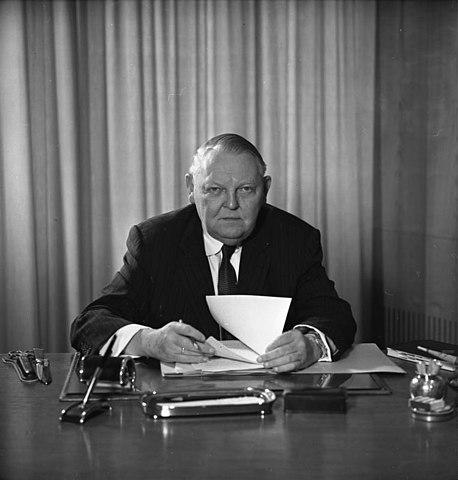 Ludwig Erhard (1897-1977), Chancellor of Germany from 1963 to 1966Photo: Bundesarchiv, B 145 Bild-F015320-0001 / Patzek, Renate / CC-BY-SA 3.0 no changes made
Ludwig Erhard (1897-1977), Chancellor of Germany from 1963 to 1966Photo: Bundesarchiv, B 145 Bild-F015320-0001 / Patzek, Renate / CC-BY-SA 3.0 no changes made
Despite the election victory of the CDU, Erhard failed to gain sufficient prestige as head of government. When the FDP ministers withdrew following a dispute over the budget, his fate was sealed. At the request of his own party, Erhard resigned.
His party colleague Kurt Georg Kiesinger became 1 Dec. 1966 elected Chancellor as his successor. He formed a coalition cabinet with the SPD, whose leader, Brandt, became Vice Chancellor and Minister of Foreign Affairs. This Great Coalition managed to reverse the economic recession of 1966 and bring about some recovery. Still, there were friction points between the coalition partners, especially in the field of foreign policy. In 1969, a small victory by the SPD in the Bundestag elections caused the Great Coalition to fall apart.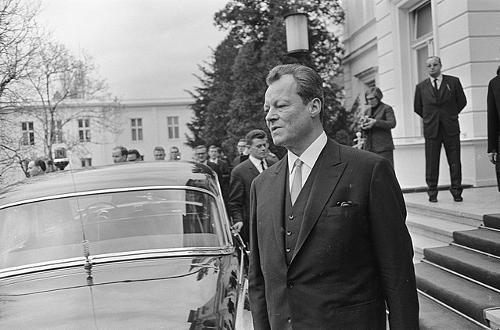 Willy Brandt, Chancellor of Germany from 1969 to 1974 and Nobel Peace Prize winnerPhoto: Anefo in the public domain
Willy Brandt, Chancellor of Germany from 1969 to 1974 and Nobel Peace Prize winnerPhoto: Anefo in the public domain
The SPD, together with the FDP, formed a new coalition led by Willy Brandt as chancellor, which, after early elections on 19 Nov. 1972 could be continued. After an espionage scandal involving one of his associates, Brandt stepped down as Chancellor in May 1974. He was succeeded by fellow party member Helmut Schmidt.
After the 1976 elections, the existing SPD-FDP coalition was continued. In the early 1970s, German politics was severely affected by the oil crisis and the strongly associated unemployment.
The 1976 elections produced another SPD / FDP coalition. The 1970s were also dominated by domestic terrorism committed by the Baader-Meinhof group or Red Army Faction. In connection with this, Berufsverbote were instituted, which meant that applicants for an official position with the government were screened for their political views. The purpose of this was to exclude politically radical thinkers.
The 1970s produced a new political trend; the environmental parties such as the Grüne Liste and the Grünen joined forces in 1980 to form a political party, the Grüne Partei.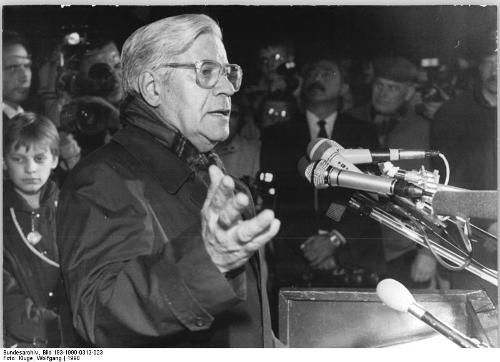 Helmut Schmidt (1918-2015), Chancellor of Germany from 1974 to 1982Photo: Bundesarchiv, Bild 183-1990-0313-023 / Kluge, Wolfgang / CC-BY-SA 3.0 no changes made
Helmut Schmidt (1918-2015), Chancellor of Germany from 1974 to 1982Photo: Bundesarchiv, Bild 183-1990-0313-023 / Kluge, Wolfgang / CC-BY-SA 3.0 no changes made
The SPD / FDP colation still achieved a fairly large majority in 1980, but then declined. There were major differences of opinion about the economic policy to be pursued and Chancellor Schmidt had problems with his supporters. In the summer of 1982 this led to a break in the coalition after which an agreement with the Christian Democrats was quickly reached and CDU leader Helmut Kohl formed a new government.
The elections of March 1983 yielded the CDU a seat gain and the Greens entered the Bundestag as the fourth fraction with 27 seats. The center-right Kohl-Genscher coalition remained in power and with the new president Richard von Weizsäcker, West Germany also gained an internationally very appealing head of state and he was also a great support for the somewhat clumsy Kohl. After the 1987 elections, the Grünen turned out not to be a one-day-fly but managed to consolidate their position in parliament. At the end of the eighties, the right-wing radical Republikaner, led by Franz Schönhuber, initially took off strongly and caused a lot of unrest. However, this party was unable to exceed the 5% limit and was therefore unable to take a seat in parliament.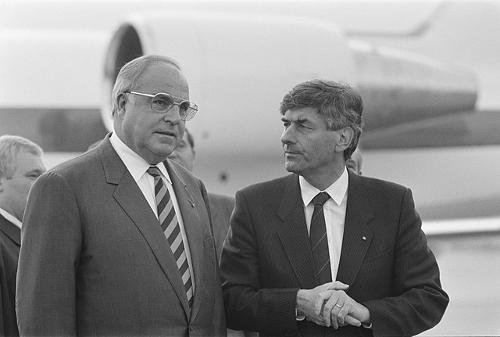 Chancellor Helmut Kohl in conversation with Dutch Prime Minister Ruud LubbersPhoto: Rob Croes / Anefo in the public domain
Chancellor Helmut Kohl in conversation with Dutch Prime Minister Ruud LubbersPhoto: Rob Croes / Anefo in the public domain
Towards the reunification of West and East Germany
In March 1985, Mikhail Gorbachev took office as political leader of the Soviet Union and the East-West balance of power in Europe slowly began to move. In Germany, relations with the GDR and the ruling SED were intensified and a policy of “Wandel durch Annäherung” was pursued. In the government statement, Chancellor Kohl spoke out clearly in favor of reunification, but the time was not yet ripe in the Soviet Union and among the leaders of the GDR. In addition, the GDR government strongly rejected the Russian course of glasnost and perestroika and as a result became increasingly weaker in the German-German relationship. During his visit to the Federal Republic, the East German leader Honecker said that the border between the two countries should connect rather than separate.
In June 1989, during his state visit to Bonn, Gorbachev suggested the possibility of tearing down the Berlin Wall.
In the summer of 1989, GDR holidaymakers fled en masse to the west, often via Eastern European countries where freedom had prevailed for some time. This accelerated the German question and in November 1989 the Berlin Wall was pulled down.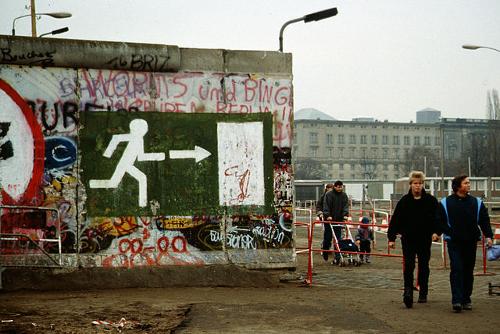 Just after the fall of the Berlin WallPhoto: Raphaël Thiémard CC 2.0 Generic no changes made
Just after the fall of the Berlin WallPhoto: Raphaël Thiémard CC 2.0 Generic no changes made
On May 18, 1990, the finance ministers of both countries signed a state treaty on economic, monetary and social unification. On May 5, talks began between the two Germans and the Allies. It was agreed that the new Germany would remain a member of NATO and that the Oder-Neisse border would be recognized by the Bundesrat and the Volkskammer. In September the CDU and the SPD merged with their East German counterparts.
On October 3, 1990, the reunification of the Federal Republic with the GDR was sealed by the Reunification Treaty.
East and West Germany reunited
In December 1990, the first parliamentary elections in a reunited Germany were won by the CDU with 44% of the vote. The SPD reached a post-war low with 33% and the Greens did not return to the Bundestag at all. The coalition between the CDU and the FDP continued, but as early as January 1991, it turned out that the costs for the entire reunification operation were much higher than budgeted and Kohl was forced to raise taxes.
The Treuhand Anstalt was given the difficult and extensive task of privatizing 8,000 state-owned companies in former East Germany and 3 million hectares of land. The divestments and closings of companies increased labor unrest in the east of Germany and a deep recession ensued throughout Germany.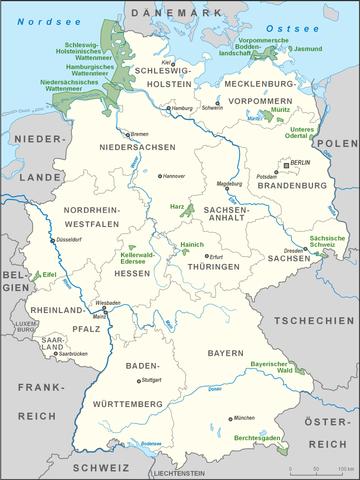 Map of Germany after the German ReunificationPhoto: Lencer CC 3.0 Unported no changes made
Map of Germany after the German ReunificationPhoto: Lencer CC 3.0 Unported no changes made
The early 1990s were also marked by increased xenophobia that forced the government to curb ongoing immigration. In July 1993, an amendment to the constitution followed, allowing refugees from so-called safe countries to be expelled and all asylum seekers admitted.
In May 1993, for the first time since the creation of the Federal Republic in 1955, armed German soldiers came into action in a non-NATO area; a U.N. operation in Somalia.
Stagnating economy
After two terms in office, Richard von Weiszäcker was succeeded as president in 1994 by Roman Herzog of the CDU. The Bundestag elections were largely dominated by economic development, which showed an earlier and stronger recovery. The CDU had the worst election result since 1949, but remained the largest party and was once again able to form a coalition government with the liberal FDP led by Helmut Kohl, who was elected Chancellor for the fourth time with a single majority vote. It was remarkable that the extreme right-wing parties did not gain a foothold.
In 1995 economic growth stagnated and unemployment remained high, especially in the former GDR. That is where growth was strongest, mainly due to government investments in construction and infrastructure.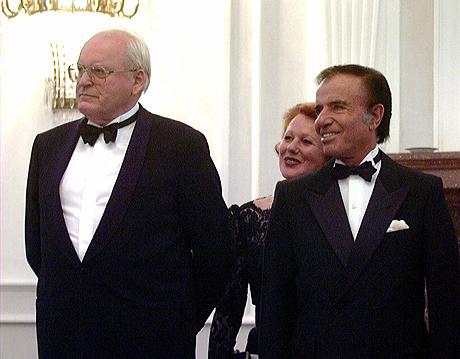 Federal President Roman Herzog and Argentine President Carlos MenemPhoto: Presidencia de la Nación Argentina CC 2.0 Generic no changes made
Federal President Roman Herzog and Argentine President Carlos MenemPhoto: Presidencia de la Nación Argentina CC 2.0 Generic no changes made
Despite concerns from the Bundesbank, the government continued to support plans for a single European currency. In 1996 talks on Economic and Monetary Union (EMU) sparked a fierce battle against almost all other EU countries, with Bonn defending the pursuit of the "hardest" possible euro, the future common currency. In addition to embedding the D-mark in a monetary union, the German economy faced several other interconnected problems in 1996: the economic and psychological divide between the east and the west of the country, the modernization of the welfare state and reorganization. of public finances. In addition, some cracks came to light internationally in the Bonn-Paris axis, where French protectionism clashed with the German pursuit of free trade. The considerably improved relationship with the Netherlands was expressed in 1995, among other things, in the formation of a Dutch-German military unit.
Thanks to additional privatizations and budget cuts, the budget deficit came to 3% in 1997, exactly the demand that Germany itself had set for participation in EMU. The government's announcement in March 1997 to drastically cut multi-billion coal mining subsidies until 2005 sparked massive demonstrations from trade unions, after which the government decided to postpone the clean-up.
The end of the Kohl era
The Bundestag elections of September 1998 were disappointing for Helmut Kohl and in the polls his party lagged behind the SPD. With his new leader, the Prime Minister of the Land of Lower Saxony Gerhard Schröder, the Social Democrats presented themselves as the party of the Neue Mitte, with a focus on changes that were mainly economic, such as the fight against the (youth) unemployment.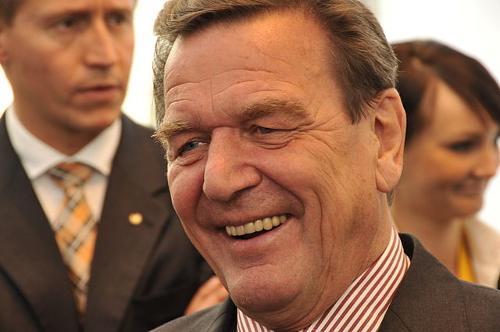 Gerhard Schröder, prime minister of GermanyPhoto: Campus Symposium GmbH CC 3.0 Unported no changes made
Gerhard Schröder, prime minister of GermanyPhoto: Campus Symposium GmbH CC 3.0 Unported no changes made
The CDU / CSU coalition had the worst result since 1949 and the liberal coalition partner FDP also lost significantly and was halved. The big winner was the SPD and it became the largest party in the Bundestag. The new government was formed from a coalition of the SPD and the Grünen that for the first time granted government power at the national level. Gerhard Schröder became the first Social Democratic Prime Minister since Helmut Schmidt. Oskar Lafontaine, representative of the left wing of the SPD, became Minister of Finance with extensive powers. The political leader of the Grünen Joschka Fischer took his place in the government as Minister of Foreign Affairs.
In December 1999, Germany was shocked by a massive corruption scandal within the CDU. Even Chancellor Kohl had accepted bribes on behalf of the CDU's party fund. Kohl, however, declined to name names and would be subject to a criminal investigation. On January 18, 2000, Kohl had to step down from his position of honorary president of the CDU, after it became clear that the party leadership no longer supported him.
Period Schröder
On foreign policy front, the new government continued to follow Kohl's line, strengthening ties with France and Great Britain. Economically, people looked with jealous eyes at the Netherlands, where the unemployment rate fell drastically due to, among other things, the polder model. However, this solution was not for the Germans and in July 1998 the unemployment rate was 10.9% of the labor force, the highest rate since 1945.
In the East German states, the situation was and is even more worrisome and there are many social problems. The new government coalition appeared to have great difficulty in working together in harmony and soon the Minister of Finance, Oskar Lafontaine, stepped down from the government and also resigned his position as party chairman.
In June 1999, the Schröder government presented a very drastic austerity program in which cutbacks amounted to approximately DM 30 billion. On May 23, 1999, Johannes Rau was elected from the SPD as the new Federal President and in the summer of that year the Bundestag, including 12,000 officials, moved to Berlin.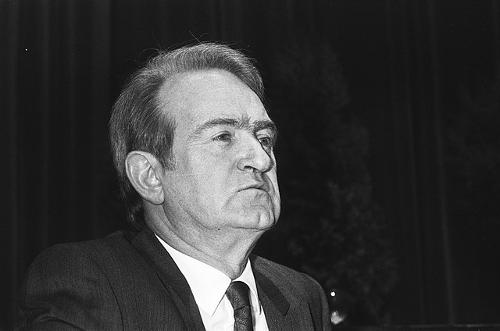 Johannes Rau, Federal President of GermanyPhoto: Roland Gerrits / Anefo in the public domain
Johannes Rau, Federal President of GermanyPhoto: Roland Gerrits / Anefo in the public domain
In 2000, the government continued to implement austerity measures and tax cuts for businesses. As a result of all these measures, the German economy showed clear signs of recovery. The economic development of the former GDR was quite successful, only the unemployment rate was significantly higher compared to the former West Germany.
The red-green government coalition led by Chancellor Gerhard Schröder won the German parliamentary elections. The election campaign fulfilled the expectations of a neck-and-neck race. SPD and CDU / CSU each received 38.5% of the vote.
Schröder may form a new government, but has been punished by the voters for his faltering economic policy. The SPD lost 2.4% to reach 251 seats, just enough to supply the largest fraction in the Bundestag. Schröder was thus held against the massive unemployment that his government had done too little to combat. More than 4 million Germans were looking for a job at that time.
Horst Köhler was designated as Germany's new head of state on Sunday, May 23, 2004. The former boss of the International Monetary Fund (IMF) received the support of the majority of the so-called Federal Assembly, the electoral college that the Federal President appoints. Köhler succeeded Johannes Rau, who was not eligible for re-election.
Köhler received 604 votes, one more than the absolute majority required. A total of 1,206 persons were allowed to determine who held the highest office in Germany until 2009. That number of 1206 is exactly double the number of seats in the parliament, the Bundestag. The 603 Bundestag parliamentarians make up one half of the Bundestag. The other 603 members are a reflection of the political relations in the federal states. These include prime ministers of the sixteen federal states, representatives of the regional parliaments, ex-politicians and well-known Germans. Although he was a CDU member since 1981, he often gained a reputation for acting commercially and politically independently. The Christian Democrats and Liberals therefore labeled him the ideal president for all Germans.
Period Merkel
The elections in September 2005 were narrowly won by the CDU / CSU (226 seats against 222 for the SPD), after which the CDU / CSU and SPD formed a grand coalition for the first time since 1966. Angela Merkel (CDU) was appointed first female Chancellor on November 22, 2005. In March 2008, Angela Merkel will pay a historic visit to the Knesset, the Israeli parliament. Merkel is re-elected in September 2009.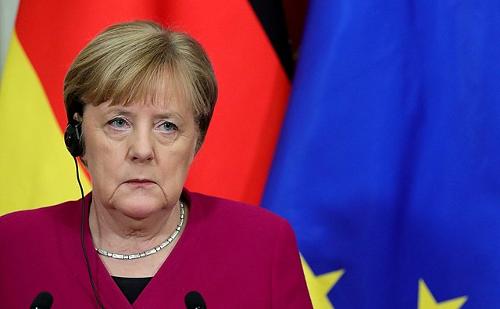 Angela Merkel, Chancellor of Germany November 22, 2005- 2021Photo: kremlin.ru CC 4.0 International no changes made
Angela Merkel, Chancellor of Germany November 22, 2005- 2021Photo: kremlin.ru CC 4.0 International no changes made
At the end of 2009 in early 2009, Germany will fall into recession and pump large sums of money into the economy. In May 2010, the parliament grudgingly approved support for the Greek economy. Public opinion is against this support. In May 2011, Germany decided to abandon all nuclear energy in the aftermath of the nuclear disaster in Japan in 2022. In September 2013, Merkel got a lot of votes in the parliamentary elections, but just not the absolute majority. In December 2013, she finalized coalition talks with the SPD and became head of government of a so-called "Grosse Koalition". Germany will introduce the minimum wage for the first time in April 2014. In September 2015, Merkel plays a decisive role in the migrant crisis. Germany take many migrants to Merkel's winged statement: "Wir Schaffen das".
In January 2016, the mood changed after sexual attacks on women, perpetrated in Cologne, among others, by perpetrators with an Arab or North African appearance. In December 2016, there was a heavy attack with a trick on a Christmas market in Berlin by the Islamic State, in which 12 people were killed. In September 2017, the populists of the Alternative fur Deutschland party took advantage of the country's vote by finishing third in the parliamentary elections. A coalition is difficult to form. Also in 2017, Frank-Walter Steinmeier will become the 12th Federal President of Germany. In March 2018, after a very long formation by German standards, Merkel took up the position as Chancellor of a new grand coalition with the SPD.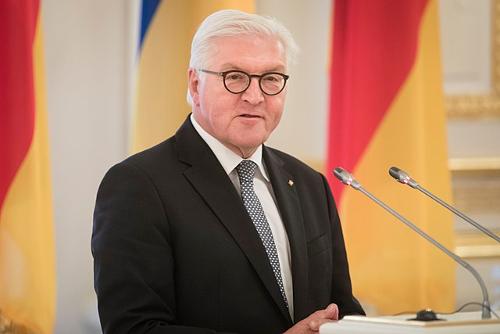 Frank-Walter Steinmeier, 12th Federal President of GermanyPhoto:Unknown CC 4.0 International no changes made
Frank-Walter Steinmeier, 12th Federal President of GermanyPhoto:Unknown CC 4.0 International no changes made
In July 2020 it will be Germany's turn to hold the presidency of the EU. Angela Merkel may be able to assert her authority one last time to get out of the difficult negotiations about the budget and the spending of the Corona funds. She will no longer be eligible for re-election in the 2021 elections in Germany.
Olaf Scholz, the 63-year-old former finance minister defied earlier expectations by winning the September 2021 election. He formed a coalition with the Greens and business-friendly Free Democrats in December, becoming the first Social Democrat chancellor since 2005. The new government plans to combat climate change with an ambitious target of phasing out coal ahead of schedule, and focusing on renewable energy.
Sources
Ayer, E.H. / Germany
Lucent Books
Egert-Romanowska, J. / Duitsland
Van Reemst
Europese Unie : vijftien landendocumentaties
Europees Platform voor het Nederlandse Onderwijs
Mark, D.F.W. van der / De Bondsrepubliek Duitsland voor en na 1990 : geschiedenis, politiek, economie en ruimtelijke ontwikkeling
Landensurveys
Tatsachen über Deutschland
CIA - World Factbook
BBC - Country Profiles
Copyright: Team The World of Info